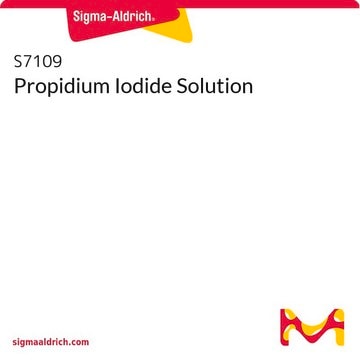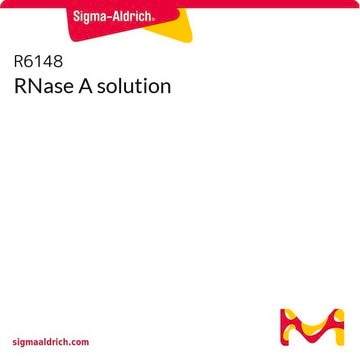P4864
Propidiumjodid -Lösung
≥94% purity, solution (1.0 mg/ml in water)
Synonym(e):
3,8-Diamino-5-(3-diethylaminopropyl)-6-phenylphenanthridinium-iodid-methiodid, 3,8-Diamino-5-[3-(diethylmethylammonio)-propyl]-6-phenylphenanthridinium-diiodid
About This Item
Empfohlene Produkte
product name
Propidiumjodid -Lösung,
Assay
≥94%
Qualitätsniveau
Form
liquid
Farbe
faint orange to very dark orange, and Faint Red to Very Dark Red and Faint Purple to Very Dark Purple and Orange-Red and Red-Orange
Löslichkeit
water: 1 mg/mL
εmax
5400-6400 at 491-495 nm in phosphate buffer
Anwendung(en)
diagnostic assay manufacturing
hematology
histology
Lagertemp.
2-8°C
SMILES String
[I-].[I-].CC[N+](C)(CC)CCC[n+]1c(-c2ccccc2)c3cc(N)ccc3c4ccc(N)cc14
InChI
1S/C27H33N4.2HI/c1-4-31(3,5-2)17-9-16-30-26-19-22(29)13-15-24(26)23-14-12-21(28)18-25(23)27(30)20-10-7-6-8-11-20;;/h6-8,10-15,18-19,29H,4-5,9,16-17,28H2,1-3H3;2*1H/q+1;;/p-1
InChIKey
XJMOSONTPMZWPB-UHFFFAOYSA-M
Suchen Sie nach ähnlichen Produkten? Aufrufen Leitfaden zum Produktvergleich
Verwandte Kategorien
Allgemeine Beschreibung
Anwendung
- DNA-Färbung
- Färbungsbasierte Viabilitätsbestimmung zur Untersuchung der Viabilität von Inselzellen
- Visualisierung von F-Aktinen und Kernen in Schichten mesenchymaler Stammzellen
Ähnliches Produkt
Lagerklassenschlüssel
12 - Non Combustible Liquids
WGK
WGK 1
Flammpunkt (°F)
Not applicable
Flammpunkt (°C)
Not applicable
Persönliche Schutzausrüstung
Eyeshields, Gloves
Choose from one of the most recent versions:
Analysenzertifikate (COA)
Don't see the Right Version?
If you require a particular version, you can look up a specific certificate by the Lot or Batch number.
Besitzen Sie dieses Produkt bereits?
In der Dokumentenbibliothek finden Sie die Dokumentation zu den Produkten, die Sie kürzlich erworben haben.
Kunden haben sich ebenfalls angesehen
Artikel
Zellbasierte Assays für Zellproliferation (BrdU, MTT, WST1), Zellviabilität und Zytotoxizitätsversuche für Anwendungen in der Krebs- und Stammzellforschung und in den Neurowissenschaften.
Cell based assays for cell proliferation (BrdU, MTT, WST1), cell viability and cytotoxicity experiments for applications in cancer, neuroscience and stem cell research.
Verwandter Inhalt
Nancy-520 for DNA Detection and Quantitation
Three-dimensional (3D) printing of biological tissue is rapidly becoming an integral part of tissue engineering.
Unser Team von Wissenschaftlern verfügt über Erfahrung in allen Forschungsbereichen einschließlich Life Science, Materialwissenschaften, chemischer Synthese, Chromatographie, Analytik und vielen mehr..
Setzen Sie sich mit dem technischen Dienst in Verbindung.









